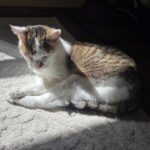In stressful, stirred-up times like these, any effort you make to increase your resilience will serve you well. Once you understand your sensitive temperament and the needs that come with it, you can go about setting up the self-care and support you need.
July is here. Our dahlia plants are shooting up. Each year I find myself marveling that a homely, thumb-sized tuber can produce a five-foot-tall plant. I have a lot in common with my dahlias. We both require more painstaking care than any other flower in the garden.
I’ve had moments—as you may have had—when my self-care requirements as a highly sensitive person have felt like a burden. I’ve criticized myself for needing what I need. For years, I attempted to treat myself as if I were a different kind of plant than I am. In the past, I suffered serious illness and exhaustion as a result of self-neglect. I hadn’t made up my mind that consistent self-care was truly worth the trouble.
Given the challenging requirements of sensitive self-care, is it worth the trouble? Yes. Even though it has taken me years of painstaking self-observation, experimentation, and inner work, I’m living proof that once we find the right environment, the right care, and the right support, HSPs, like dahlias, explode with energy and creativity. Dahlia plants produce a flood of spectacular flowers nonstop for three months. For me, blooming has meant a profound shift in my stance towards life.
In the past, I just tried to get through each day. At times, I struggled to do even that much. Now, I wake up looking forward to the day. I know what self-care I need to access to my sensitive strengths of empathy, listening, attunement, and spiritual intuition— and that self-care is built into my daily schedule.
When your circumstances challenge you, the right self-care can help you create resilience, minimizing your susceptibility to external stressors. Each of us is resourced differently. Where are you strong? Where do you feel shaky? What support, routines, or resources would you need to be even more resilient than you are now? Here are five pieces of sage advice a skilled dahlia grower would give you if you asked what it takes to bloom profusely.
1—Get rest. Insane amounts of rest.
We dig up our dahlias every fall after the first hard frost. They need a long rest—six months, to be exact. They also need to be divided. During the summer, each tuber replicates into a clump of tubers, often packed in a tight tangle. To grow properly next year, though, each tuber needs to start out alone.
This is an apt metaphor for HSPs. We need a lot of sleep: eight to nine hours each night. If you feel under-resourced in any way, and are not getting ample sleep, that’s the very first place to look for a solution. In addition to sleep, we need processing time, alone, with no new stimulation coming in. Otherwise, we end up feeling mentally and emotionally crowded, congested, cranky, or overwhelmed. This processing can happen while you are awake but otherwise occupied with puttering, gardening, making something with your hands, cooking, hiking, or running. It may also require conscious effort like journaling or pondering.
In times of stress or change, you, like me, will likely need more processing time, conscious and unconscious. Right now, for example, I’m undergoing the difficult process of examining my own implicit bias and my role in the racial disparity here in the U.S. This takes energy. I’ve found I need nine hours in bed each night to feel adequately rested. I’ve also had a series of vivid dreams, amounting to an internal course of spiritual instruction. To understand the dreams I need to sit with them and ponder them. All this takes time, and my schedule has no padding in it. So I’ve decided to put my book writing on pause for now.
2—Be persistent
In the early years I stored our dahlia tubers in the basement. I tried peat moss; shredded paper; the wood chips meant for dog beds; and vermiculite. Some tubers rotted. Others shriveled. Enough tubers would survive to plant for the next spring, but barely.
After 10 years of struggling, I finally realized that our basement was simply too warm. I found a tiny dorm refrigerator on Craigslist, set it to 45 degrees, and tucked the tubers in it. Finally, stored at just the right temperature, they came through with flying colors.
Like my tubers, I too spent years in survival mode: getting by, but barely. It took me years to accept the reality that my marriage wasn’t working. In the meantime, I had cultivated a number of forms of self-care: yoga, exercise, meditation. But the relationship was stressful and my inner relationship was still full of anxiety, shame, and self-doubt.
Sheer persistence carried me through all this. If you are sensitive, persistence is essential. If you feel fragile or under-resourced in any way, treat yourself like you would treat a beloved child who has a mysterious ailment. With such a child, you would do absolutely everything you could to find a remedy, while stubbornly holding on to the vision of how life could be and will be once the child is well.
To do this for yourself, you first must accept the reality of the level at which you are functioning. If it is not optimal, doggedly pursue all means possible to build your increase your sensitive resilience. Hold in mind the vision of how you’d like to feel and to contribute. When the going is rough, remind yourself of this vision.
3—Find your pace
It’s a big transition to leave the dark, cool refrigerator each April. Dahlia tubers need a few days at room temperature to “wake up”, then a month in pots in the kitchen to get started. That’s how it is for HSPs as well. We do best when we can take our time before diving in to a new challenge. Does your schedule allow you that? Can you take the time you need to wake up in the morning? To transition between activities?
Knowing your pace is a big part of sensitive self-care. I pinch back our plants so they don’t get too leggy and spindly. Similarly, I have to be ruthless about pruning back some projects early on. I have to be really clear what I’m willing to spend time on. Even hour by hour, I have to set a timer to remind myself to take breaks. HSPs are passionate. We can overwhelm ourselves, trying to take on too much.
4—Set up sturdy support systems
Dahlias can’t support their own weight alone. Ours need sturdy metal stakes, which go into the ground next to the tuber right from the start, at planting time. This proactive approach to setting up support systems is essential for us as HSPs. I used to wait until I felt awful to get help, whether from a chiropractor, a therapist, or a friend. Now I proactively schedule support: body work once a month, therapy once a month, and focusing partnership exchanges twice a week.
On top of this I rely on the mutual support of my partner, my family, and my friends. We all get top-heavy and teeter sometimes. With a strong support system in place, you can weather even heavy blows without falling over. As HSPs, we need other people at times to help us hold a space for our intense emotions and our complex thought processes. I think of my relationships as outriggers. The more outriggers, the more stable the canoe….and the better I can function as an outrigger for other people.
5—Express your creativity and spirituality
Dahlias have to be dug up, divided, stored, started, staked, pinched. Considering I’m a rather lazy gardener, you might wonder why I bother. If you have any doubt, the first image above might dispel it. Each of those plants produces a spectacular display with dozens of flowers, in bloom continuously from July to October. And here’s my favorite part: the more you cut dahlia flowers, the more the plant blooms. I can fill every vase we own with flowers, and still have plenty to enjoy out in the garden.
My dahlia plants remind me of the generous nature of our HSP creativity. This creativity needs to be expressed. The more we express it, the more it pours out, and the more energized we feel. If we don’t express our creativity, it stagnates and we get anxious and depressed. When I refer to “creativity”, I don’t just mean the creative arts like painting, music, or writing. I mean getting what is in you, out into the world—whatever that means to you.
I used to express creativity through playing the oboe. Now, I do it through client work and teaching. To create a space of radical acceptance, to find effective ways to convey complex or subtle concepts, to write materials that facilitate inner growth—these are intensely creative outlets. I also love to create order around the house, to create systems that support ease, to create color patterns in the garden. There is always something new to play with.
For HSPs, creative expression is ultimately a form of spiritual expression. The more you open to your essential spirituality and let it inform your actions, the more creative you become, and the more you increase your sensitive resilience. This resilience, in turn, empowers you to offer your abilities and skills to the world. Yes, this takes sustained effort. But that makes the results all the sweeter.
Image: 2020 Emily Agnew




















I am looking forward to reading your article about HSPs and creativity. I have been struggling with what my creativity is. Thank you also for providing a wider perspective on what creativity is…not just artistic creativity. I would just like to share something that I was told a few months ago by a psychologist….in reference to your statement that ‘we all get top heavy and teeter sometimes’. The psychologist stated that intelligent people are like an upside down triangle and eventually we do teeter over. I was told I needed to strengthen my physical body …so my life would represent a triangle with the wide base at the bottom….so no teetering (or hopefully less for us HSPs). Given the fact that HSPs use their brains in depth processing, I am going to guess that our intelligence levels are high and therefore we need daily physical activity. I have gradually been increasing my daily length of physical activity over the past few months. All I have been doing is walking and snowshoeing. However, I have noticed that I feel taller and stand with more confidence. People who once looked much taller than me in their attitude (although actually physically shorter than me) now look smaller in their attitude. I’m guessing only an HSP would pick up on this subtle form of non verbal communication. Thank you always for the informative articles. I also appreciate the fact that I can share my experiences and reflect and comment and ask questions.
S, yes, I think it is particularly important for HSPs to have physical activities they enjoy to keep them grounded in the body, given our depth of processing.